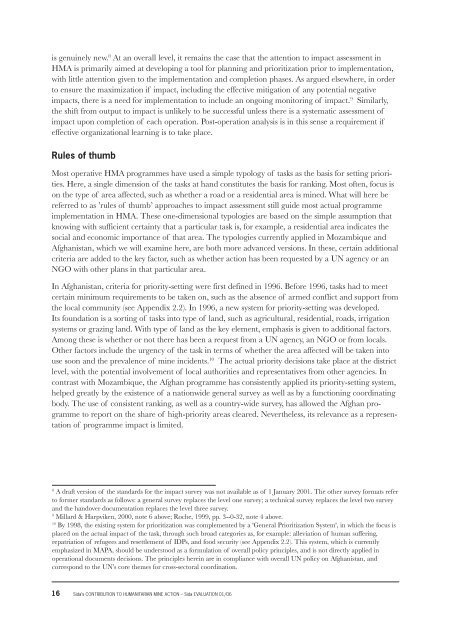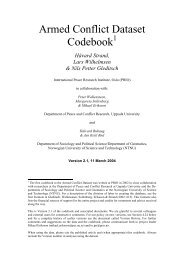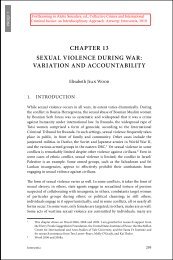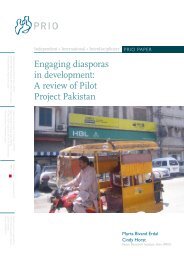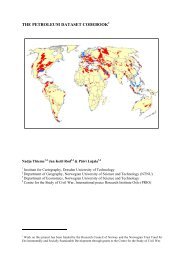is genuinely new. 8 At an overall level, it remains the case that the attention <strong>to</strong> impact assessment inHMA is primarily aimed at developing a <strong>to</strong>ol for planning and prioritization prior <strong>to</strong> implementation,with little attention given <strong>to</strong> the implementation and completion phases. As argued elsewhere, in order<strong>to</strong> ensure the maximization if impact, including the effective mitigation of any potential negativeimpacts, there is a need for implementation <strong>to</strong> include an ongoing moni<strong>to</strong>ring of impact. 9 Similarly,the shift from output <strong>to</strong> impact is unlikely <strong>to</strong> be successful unless there is a systematic assessment ofimpact upon completion of each operation. Post-operation analysis is in this sense a requirement ifeffective organizational learning is <strong>to</strong> take place.Rules of thumbMost operative HMA programmes have used a simple typology of tasks as the basis for setting priorities.Here, a single dimension of the tasks at hand constitutes the basis for ranking. Most often, focus ison the type of area affected, such as whether a road or a residential area is mined. What will here bereferred <strong>to</strong> as ’rules of thumb’ approaches <strong>to</strong> impact assessment still guide most actual programmeimplementation in HMA. These one-dimensional typologies are based on the simple assumption thatknowing with sufficient certainty that a particular task is, for example, a residential area indicates thesocial and economic importance of that area. The typologies currently applied in Mozambique andAfghanistan, which we will examine here, are both more advanced versions. In these, certain additionalcriteria are added <strong>to</strong> the key fac<strong>to</strong>r, such as whether action has been requested by a UN agency or anNGO with other plans in that particular area.In Afghanistan, criteria for priority-setting were first defined in 1996. Before 1996, tasks had <strong>to</strong> meetcertain minimum requirements <strong>to</strong> be taken on, such as the absence of armed conflict and support fromthe local community (see Appendix 2.2). In 1996, a new system for priority-setting was developed.Its foundation is a sorting of tasks in<strong>to</strong> type of land, such as agricultural, residential, roads, irrigationsystems or grazing land. With type of land as the key element, emphasis is given <strong>to</strong> additional fac<strong>to</strong>rs.Among these is whether or not there has been a request from a UN agency, an NGO or from locals.Other fac<strong>to</strong>rs include the urgency of the task in terms of whether the area affected will be taken in<strong>to</strong>use soon and the prevalence of mine incidents. 10 The actual priority decisions take place at the districtlevel, with the potential involvement of local authorities and representatives from other agencies. Incontrast with Mozambique, the Afghan programme has consistently applied its priority-setting system,helped greatly by the existence of a nationwide general survey as well as by a functioning coordinatingbody. The use of consistent ranking, as well as a country-wide survey, has allowed the Afghan programme<strong>to</strong> report on the share of high-priority areas cleared. Nevertheless, its relevance as a representationof programme impact is limited.8A draft version of the standards for the impact survey was not available as of 1 January 2001. The other survey formats refer<strong>to</strong> former standards as follows: a general survey replaces the level one survey; a technical survey replaces the level two surveyand the handover documentation replaces the level three survey.9Millard & Harpviken, 2000, note 6 above; Roche, 1999, pp. 3--0-32, note 4 above.10By 1998, the existing system for prioritization was complemented by a 'General Prioritization System', in which the focus isplaced on the actual impact of the task, through such broad categories as, for example: alleviation of human suffering,repatriation of refugees and resettlement of IDPs, and food security (see Appendix 2.2). This system, which is currentlyemphasized in MAPA, should be unders<strong>to</strong>od as a formulation of overall policy principles, and is not directly applied inoperational documents decisions. The principles herein are in compliance with overall UN policy on Afghanistan, andcorrespond <strong>to</strong> the UN’s core themes for cross-sec<strong>to</strong>ral coordination.16 Sida’s CONTRIBUTION TO HUMANITARIAN MINE ACTION – Sida EVALUATION 01/06
In Mangane, Nampula province, a large demining project was launched <strong>to</strong> res<strong>to</strong>re access <strong>to</strong> a major waterpipeline serving the larger city of Nacala. The task was a clear priority by NMCC standards, and the task hadhigh importance at the provincial level. At the same time, no attention was given <strong>to</strong> the potential impact on thecommunity in whose vicinity the operation is conducted. There was minimal communication between the opera<strong>to</strong>rand locals, and amongst the latter there was an emerging feeling that assistance providers <strong>to</strong>tally neglected theirsituation. This could have been avoided if local-level impact had been identified and followed up. In this case,given that people have confidence in clearance, they may benefit in several ways, including regaining access <strong>to</strong>former areas for agricultural and coal production. In this case, on the basis of a rough approach <strong>to</strong> impactassessment, local-level impact was neglected.Illustration 2.1: Neglecting impact at the community level 11In Mozambique, the system that is currently in use is also a refined rules of thumb approach. Developedby the National <strong>Mine</strong> Clearance Commission (NMCC) in 1998, it has been integrated in<strong>to</strong>NMCC standard survey forms, applied by all major demining agencies. 12 Here, priorities are rankedby type of task, but the typology also includes considerations about level of impact ranging from thenational <strong>to</strong> the community. There are three main categories: high, medium and low priority, each withthree subcategories, making a <strong>to</strong>tal of nine categories (see Appendix 2.1). This is an advanced versionof the one-fac<strong>to</strong>r typology in that each category in this systemtakes in<strong>to</strong> account type of area, its larger function, as well as the societal level <strong>to</strong> which it is relevant.Distinctions between categories are ambiguous, and the judgement of the enumera<strong>to</strong>r is decisive forranking. Although the NMCC standard form is widely applied, the ranking prescribed therein is notkey <strong>to</strong> agencies priority-setting. Rather, this tends <strong>to</strong> be based on the so-called ’common sense’ of highlevelmanagers. Ultimately, the data generated by the system applied in Mozambique are insufficient asa basis for making even the most general assessment of impact.Generally, rules of thumb approaches <strong>to</strong> impact assessment have several weaknesses. Their capacity <strong>to</strong>engage and represent the views of affected populations is limited. As exemplified above, the inability <strong>to</strong>focus simultaneously on impact at various levels is a weakness. Rules of thumb may be used for initialpriority-setting, but have little value at later phases in the project cycle, including the planning, implementationand post-clearance phases. Since rules of thumb also operate with broad categories, whichare not necessarily easily distinguishable, they are vulnerable <strong>to</strong> the biases of individuals. This is closelylinked <strong>to</strong> the problem that with such rough data, decisionmakers more easily become focused onconstraints, as opposed <strong>to</strong> impact, in decisionmaking. The disadvantages of rules of thumb approachesonly intensify as one moves away from the most immediate emergency stage.Economic analysisThe use of economic analysis for impact assessment has a long tradition in aid and development, andit can build on a well-defined analytical apparatus as well as a substantial body of knowledge. Thegeneral objective of economic analysis is <strong>to</strong> establish future returns on various types of investment, andits most common form is cost-benefit analysis. The approach is open <strong>to</strong> the inclusion of a multitude offac<strong>to</strong>rs, and its most common application is <strong>to</strong> establish a template that can be applied across a numberof similar situations. In contrast <strong>to</strong> other impact-assessment approaches, the focus tends <strong>to</strong> be oneconomic values only, although one would find that some analysts place a price on a non-economicvalue in order <strong>to</strong> be able <strong>to</strong> build it in<strong>to</strong> their calculus.11Based on a community study in Millard & Harpviken, 2000, Chapter 7, note 6 above.12Republica de Mocambique, 1998. The National <strong>Mine</strong> Clearance Strategy Approach (Draft), Mapu<strong>to</strong>.Sida’s CONTRIBUTION TO HUMANITARIAN MINE ACTION – Sida EVALUATION 01/06 17
- Page 4: This report is part of Sida Evaluat
- Page 9 and 10: MDDMEDDSMGMMLSWMoPHMOUMPLANATONDING
- Page 12 and 13: the conclusions of this report is t
- Page 14 and 15: A prime concern with Mine Action Ce
- Page 16 and 17: 3. The coordination of mine action,
- Page 18 and 19: an needs and the needs of victims o
- Page 20 and 21: At the same time as Sida has been o
- Page 22 and 23: er, throughout the data collection,
- Page 24 and 25: Donors may feel that the costs of i
- Page 28 and 29: The first attempt to apply a form o
- Page 30 and 31: standard for basic impact surveys.
- Page 32 and 33: Community studiesCommunity studies
- Page 34 and 35: and progress monitored in all phase
- Page 36 and 37: 3 Implementation ChannelsOver the p
- Page 38 and 39: cal implementation and management,
- Page 40 and 41: ing that demining has any effect at
- Page 42 and 43: actual response. In an effort to ov
- Page 44 and 45: ecently developed. The approaches t
- Page 46 and 47: A different tool that will be used
- Page 48 and 49: Alternative implementation channels
- Page 50 and 51: appear to have been doing a good jo
- Page 52 and 53: Coordination may at times even be c
- Page 54 and 55: itarian and development effort. Imp
- Page 56 and 57: Two). In terms of coordinating mine
- Page 58 and 59: ased demining of AREA. Another type
- Page 60 and 61: The Kosovo UNMACC took a number of
- Page 62 and 63: would be accredited and tasked by U
- Page 64 and 65: programme. The proposal was backed
- Page 66 and 67: The present landscape of Swedish ac
- Page 68 and 69: demining purposes. Buoyed by a wave
- Page 70 and 71: given that SRSA also recruits perso
- Page 72 and 73: teams. The need for a breeding capa
- Page 74 and 75: 6 RecommendationsIn the preceding c
- Page 76 and 77:
• MACs should operate with agreem
- Page 78 and 79:
7 ConclusionIn this report, we have
- Page 80:
70Appendix 1
- Page 89 and 90:
Ziauddin Operations Officer METADup
- Page 91 and 92:
Bennedich, Claes Department for eva
- Page 93 and 94:
Appendix 3BIBLIOGRAPHYAccelerated D
- Page 95 and 96:
Faulkner, F. & L Pettiford, 1998.
- Page 97 and 98:
McGrath, Rae, 2000. Landmines and U
- Page 99 and 100:
Miscellaneous DocumentsBrady, Justi
- Page 101 and 102:
Appendix 4Sida’s CONTRIBUTION TO
- Page 103 and 104:
Appendix 6• The area must be secu
- Page 105 and 106:
Appendix 7Locality identifier: Dist
- Page 107:
Recent Sida Evaluations00/37:1 Asse


